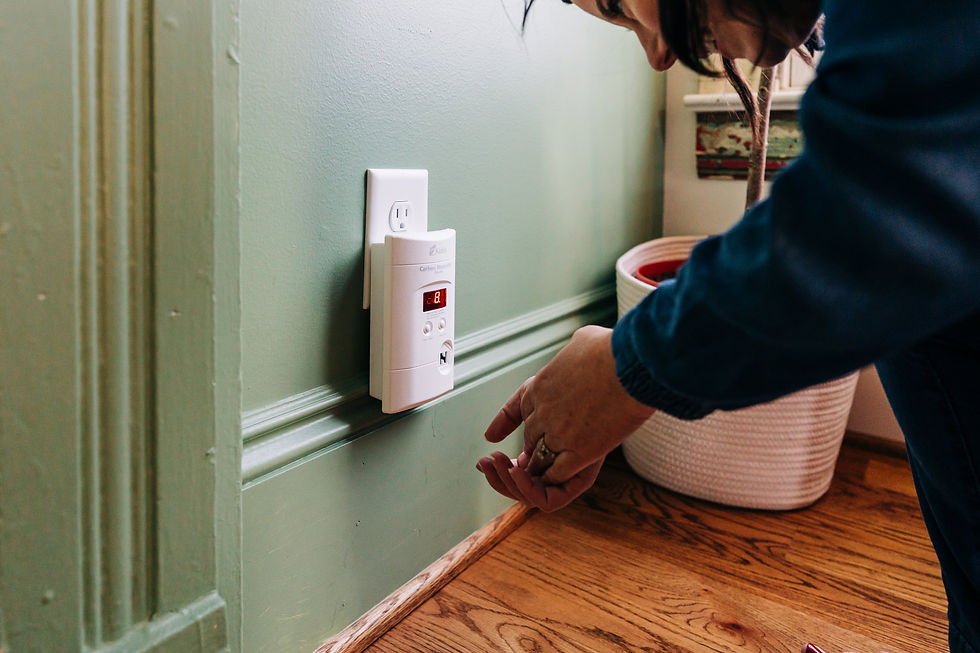To protect all occupants in schools, key code councils have to move out of the CO dark age
- Nikki James Zellner

- Aug 14, 2021
- 4 min read
An excerpt from NFPA Research Foundation's Carbon Monoxide Detection and Alarm Requirements: A Literature Review summary:
"Regarding carbon monoxide detection, the IFC and NFPA Codes generally address attached garages, rooms containing fuel burning appliances, and spaces served by fuel-burning HVAC systems.
There are several cases of CO incidents that have occurred outside of these areas.
For example, incidents that relate to leaks from exhaust system ductwork and equipment (including failure of exhaust fans), which would be outside where the fuel burning appliance is located, yet its CO emission are carried elsewhere.
These are the kind of CO migration details that are not recorded, making it difficult to fix this problem.
Regulations on CO detection differ significantly state to state.
States typically adopt a model code (IFC, or NFPA 101), and may have state-specific amendments.
In some cases, states do not have a statewide adoption of any code. The most impactful details, however, is the edition year of the respective codes that are adopted, and the means of enforcement.
Provisions in codes generally become more stringent with more recent editions, but many states have 2012 or 2015 adoptions, and some adoptions are as old as 2006.
Further, many states let their local jurisdictions make amendments or even completely let them handle code adoption.
Additionally, local jurisdictions are also often seen to be responsible for enforcement of these codes.
This leads to inconsistent CO regulation across the US—which can be observed from New York having CO detection requirements for all buildings, while some states do not regulate any buildings.
Out of the various issues that are associated with CO poisoning, one prominent issue is a lack of comprehensive, concise, and coordinated data for these kinds of incidents, and data is required to substantiate regulatory changes.
While fire related incidents are well documented, data collection on CO poisoning incidents are limited.
For example, injuries and deaths of non-fire CO incidents are not recorded within NFIRS, only incident totals are reported.
Similarly, the CPSC does thorough work in their data collection, yet their jurisdiction is limited, and therefore their data is also limited.
Despite shortcomings in available data, there is still enough information to draw some conclusions."
NFPA has taken the first step in acknowledging we have a CO detection problem as a nation.
It was this report, along with an ask from Kris, founder of the Jenkins Foundation, that compelled me to submit my incident reports and Case Study Unprotected: A Case Study of carbon monoxide incidents in U.S. schools and daycares (2021) to the NFPA, to supplement their Literature Review and support their call for data.
My report showed 200 cases of Carbon monoxide incidents in schools and daycares. It showed 2,400+ medical injuries due to CO in schools/daycare occupancies that could be confirmed. That is not okay.
A code council's responsibility isn't to find funding or be concerned with cost impact. A code council's responsibility is to set the standards for life and injury protection of occupants. And right now our code is in the Dark Ages, pleading the 5th on a problem it knows exists.
But the NFPA is taking steps to remedy this and step into the light.
The NFPA works by Occupancy Types – and in relation to the schools conversation, our occupancy types are:
New Educational Occupancies
Existing Educational Occupancies
New Daycare Occupancies
Existing Daycare Occupancies
New Daycare Homes
Existing Daycare Homes
There are dedicated Chapters in the NFPA 101 code that reference these occupancy types – but, as of the NFPA 101 Life Safety Code (2021 edition) only one of them had language around CO detection: New Educational Occupancies.
This means that there was ZERO language (and therefore zero protection) in states that use the NFPA 101 as their guidance for CO detection for existing schools, new and existing daycares, and daycare homes.
The NFPA code typically has a three to five year cycle - meaning the 2021 code book has just been released, and any public inputs accepted for the next cycle are inputs and requested revisions for the 2024 edition.
Again, this process started many months ago for me - it’s not something that happens in a day. It's gathering data, submitting data, sending certified copies, requesting attendance, getting approved to speak, presenting, defending...it was nerve-wracking and time sensitive.
But one thing I liked about the NFPA – it wasn't as rigid, and it was far more welcoming of public input, than the IFC (sorry folks, that reception was brutal). I value the contribution mindset and community input, and so the NFPA are definitely my kind of people.
Here I was, a random mom with one hell of a story, presenting my data to skilled, educated technicians, fire marshals, code enforcers, school systems...
My inputs "sailed through with very little edits" according to one SAF-END Technical Committee member, largely because I had data the NFPA didn't have.
I made the case to include ALL educational and daycare occupancies in CO language – and every input received a "motion to create a first revision" unopposed.
Cheers to making it through the first round, and hopefully on our way to safer schools and daycares in the near future.
Important side note:
Not every state uses NFPA 101 (in full, or in part) but every state could should they choose to adopt this as their code for CO detection. States that currently use NFPA 101 in full or in part are: In full: Connecticut, Illinois, Louisiana, Nebraska; In part: Delaware, Florida, Maine, Maryland, Vermont, West Virginia, Massachusetts.

Comments